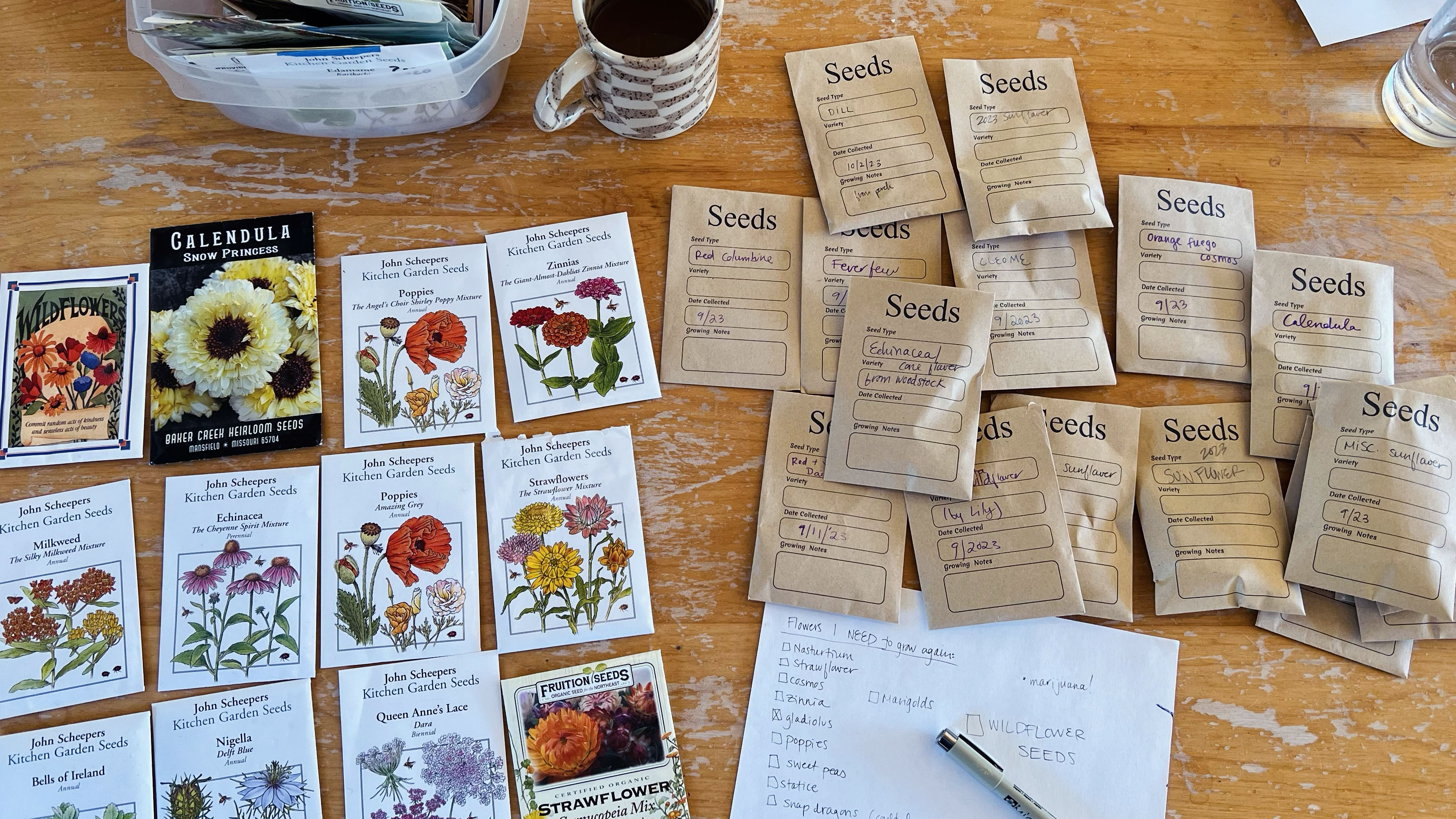
A nudge to get growing this year
Happy third day of meteorological spring! Today’s newsletter is the first in a new series focused on providing tips, resources, and inspiration for gardening. To kick things off, I’m sharing just a few ideas for starting a garden from seeds. You’ll also find three invitations at the bottom, including snail-mail seed swapping and a request for your recommendations of gardens/gardeners to feature in this series.
Who’s pumped for grow-season 2024?! I clearly am 🙂 Respond to this email to tell me what you’ll be growing this year, I’d love to hear from you.
— Willa


I see gardening as an integral part of building the future.
I can’t fully articulate why I feel this way, because it’s intuitive, but it definitely has to do with humans’ dire need to reconnect to nature, and to natural cycles. If we want to survive and thrive beyond fossil fuels and fascism and the vast fuckery of today’s world, we need to understand ourselves as ecosystem-entrenched beings who are part of an undulating web of living, dying, forever-mutating matter. And this isn’t just a situational fact—it’s also what makes us, and life itself, so damn cool.
Growing plants is the most direct, accessible way to develop a hands-on relationship with the world of non-human living species—including plants, pollinators, microbes, and mycelia. Plus, it’s fun, it’s largely inexpensive, and it’s been scientifically proven to be good for you (for a bunch of different reasons). Gardening is also creative and cross-species-collaborative; it’s literally planting seeds for the benefit of your future self. It teaches abundance, and proves how openly giving the natural world can be when we show it just the tiniest bit of care and attention.
I believe you can grow things no matter where you live, even if that means your undertaking is limited to a few pots in your sunniest window. If you’re strapped for space, you can also look beyond your own home by volunteering at a community garden (find a garden near you here!), or by teaming up with a neighbor who has more outdoor space than you (hint: gardeners tend to love it when someone offers to help). Even if you live on a spaceship, you can find a way to garden. The act of growing is completely malleable, and can be tailored to suit the exact amount of time, space, and interest you have.
Simply put: Gardening should be for everyone, and we can always learn more from what the garden has to offer.

^ A seed packet in a gift shop that made me LOL, but that I also agree with.
*
As a project-within-a-project, today I’m starting a new series called Imagining a Garden.
The intention is to share strategies and resources for growing edible, beautiful, and beneficial plants. I’ll be visiting other people’s gardens—indoor and outdoor, large and small, thriving and up-and-coming—to explore their methodologies and learn about what they grow and why. I’ll also be sharing tips and hard-won lessons from my own adventures in ~experimental horticulture~, and documenting some of our 2024 gardening pursuits as they unfold in real time.
So much of gardening involves simply imagining what might be possible, and that’s what I’m excited to explore. Often what comes to fruition is very different from the original vision, but that’s part of the fun. It’s a creative, multifaceted and predictably-unpredictable process.
As a first edition of this new series, today I’m sharing some inspiration for seeding your 2024 garden(s). With spring just around the corner, it is one of my favorite times of year: Time to start imagining and planning.

^ Taking over our dining table with seeeeeeds
What are you seeding for 2024?
At my house, the chartreuse tips of daffodil shoots are just beginning to poke up from their winter slumber. White snowdrops, blue squill, and purple periwinkles will soon open their delicate faces to the sun. We’ve had a few warm days already, so I know the soil is waking up. In a few weeks the peepers will start chirping, and it will be time to direct-sow cold weather crops like peas and spinach.
As I start to imagine my family’s 2024 garden, I am digging into my saved-seed stash to see what I have on hand. I’m also reviewing last year’s gardening notes and thinking about what grew well versus what struggled, so I can try and improve upon things this time around. That’s the nice thing about gardening: Each year that you’re still alive and kicking, you get another season, another turn of the earth, to try again.

^ Sitting in my dead-feeling garden, thinking about what was, and what will be
*
Now is also the time of year when plant-and-seed companies do their best to take advantage of people like me who are chomping at the bit to kick off a new year in the garden. As the kaleidoscopic, floriferous marketing emails and catalogs proliferate in my inbox and mailbox, I find myself drooling practically no matter what seeds are on offer.
Luckily, unlike impulse-buying clothes or other crap you don’t need, impulse-buying seeds is a weirdly strategic way to commit yourself to your future garden. If you order a bunch of seeds, you’ll need to plant them… et voilà, an ambitious gardening journey is underway. (Or at least this is what I tell myself? idk)
If you want to join me in some seed impulse-buying, here are a few of my favorite seed companies to peruse:
* Fruition — They have excellent, free-to-use growing resources, and their seeds are specially adapted for short growing seasons (i.e. those of us in the northeast).
* FedCo — They’re cooperatively owned, and solely focus on ethically sourced plants. Their tome-like catalog is especially delightful, with black-and-white illustrations and a zine-y, Whole Earth vibe (order a free catalog here)
* Hudson Valley Seed Co — Great seeds with utterly gorgeous seed packet artwork. (Artists can even join their 2024 seed-packet art open call, with submissions due March 8!)
* Scheepers Kitchen Garden Seeds — A steady-Eddy seed purveyor that’s been in the biz since 1908 (!). I’m especially a fan of their habitat bulk seed mixes, which are terrific if you want to go big with a colorful, pollinator-benefiting wildflower meadow this year
I’m not trying to hawk seeds here, I just love browsing for seeds in the same way I love shopping at art supply stores, with every luscious paint color or unexpected material inspiring new ideas and creative energy. It feels like anything is possible—and indeed, it might be.
As you browse seeds, it can be helpful to keep an eye out for species you’ve witnessed growing well in your region (or, better yet, in a neighbor’s yard or garden). This will be a nice hint that the variety will do well in your own space.
While I’m all for taking a risk and trying to grow some new-to-you varieties, it’s smart to skim the growing instructions for each type of seed—some are much more complicated than others. Many seeds benefit from a head start indoors, which lengthens their growing season, ensuring that slower-growing plants will have time to flower or bear fruit before fall.
One caveat, though: Even for tricky-sounding seeds, if you direct-sow them in good-quality topsoil at your average last frost date, it’s been my experience that most will do fine, even if you ignore the instructions. Gardening is all about wild experimentation, after all 

^ These poppies wanted to be direct-sown a month before the last frost date, and then thinned… I planted them mid-May and never thinned them, whoops. They still flourished!
Choosing natives, and a helpful tool for plant discovery
It’s great to prioritize some native plants as a way to bolster your home ecosystem, but also because it will make your gardening efforts more successful. Planting species that are naturally acclimated to your region will make it more likely that you’ll grow strong, resilient plants—because if the seeds can grow in the wild without a helping human hand, they’ll be pumped to grow in your garden bed or container! (If growing seeds in a pot, just make sure it’s a large pot, and that you thin your seedlings a few weeks after they sprout, otherwise you might not get many blooms/veggies, as each individual sprout will be fighting for the limited nutrients contained within the pot.)
→ To figure out which plants are native to your area, you can use this handy native plant finder. ←
Simply type in your zip code and it will spit out a ranked list of native plants specifically chosen to help you attract and support the widest number of pollinators. 
As another tip: If you seek out perennial flowers that claim to be “pest-resistant,” you can start them in your garden this year, and then next spring you’ll have a garden full of established plants to transplant into the harder-to-cultivate, less-protected parts of your yard. This is a way to inexpensively start your own mini nursery, and keep expanding the number of flowering perennials in your yard year over year. 
A few great native varieties to try with the above trick are rudbeckia (brown-eyed susans), bergamot (bee balm), yarrow, echinacea (cone flower), milkweed, and one of my personal favorites, the sculptural, surprisingly hardy columbine. As an example, last year I grew some gorgeous rudbeckia in my garden beds, and this spring I’ll be rewarded with a bunch of established plants that I can transplant out into various spots around the edges of my yard. (Established native plants don’t need much attention or watering, so you can basically set ‘em and forget ‘em!)

^ Rudbeckia and self-seeded cleome (spider flower) from last year’s garden. Both are late-season bloomers, and tend to be the last flowers standing come jack frost’s arrival.
If you’re intimidated by seeds, don’t be. The worst thing that can happen is you spend $4 on a packet of seeds and then they don’t grow. And if this is your first time growing seeds, you can always stick to some of the easiest (but still fun) ones: marigolds, cosmos, nasturtium, zinnias, beans, and peas. At our house right now we’re growing a bean plant that my mother-in-law planted from a package of Rancho Gordo cooking beans. You can literally just stick a dried bean in the dirt and make a whole-ass plant. Seeds are amazing.
Overall, just make sure you’ve got some high-quality dirt to plant your seeds in, and that you keep them from drying out once they sprout. Do that, and honestly you’re gonna love the way you(r garden) look(s).

^ We gave out wildflower seed packets at our wedding in 2016. Last year I started some of the leftover seeds on a whim, and despite them being 7+ years old, many sprouted—including this nasturtium, one of my favorite flowers to grow, and an edible one at that! Seeds, man. They’re just the best.
*
Lastly, I have three invitations for you:
#1: Send me your garden-related questions, concerns, or topics and I’ll pick a few to research for future newsletter sends.
#2: Do you know of someone with an amazing, weird, or experimental garden (maybe it’s you!)? I’m looking for gardens to visit both IRL and virtually for this series, and I’d love your suggestions.
#3: Wanna seed swap? I saved a ton of seeds last year, and have far too many to use myself. If you live in the northeast and would like to try growing seeds sourced from my home in the Catskills, reply with your address and I’ll mail a weird seed grab-bag to the first ~20 people who respond. Also, if you have some interesting seeds to share with me, let’s do a swap. It’ll be fun!
Seeya next time,
~ Willa

“The garden suggests there might be a place where we can meet nature halfway.”
–Michael Pollan 🙂
